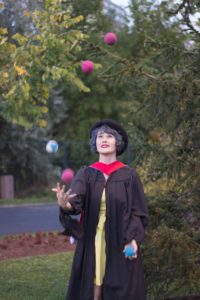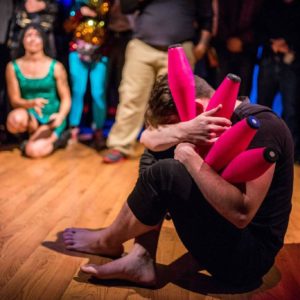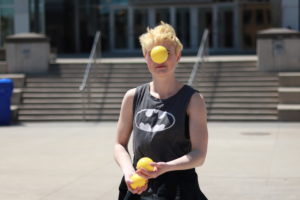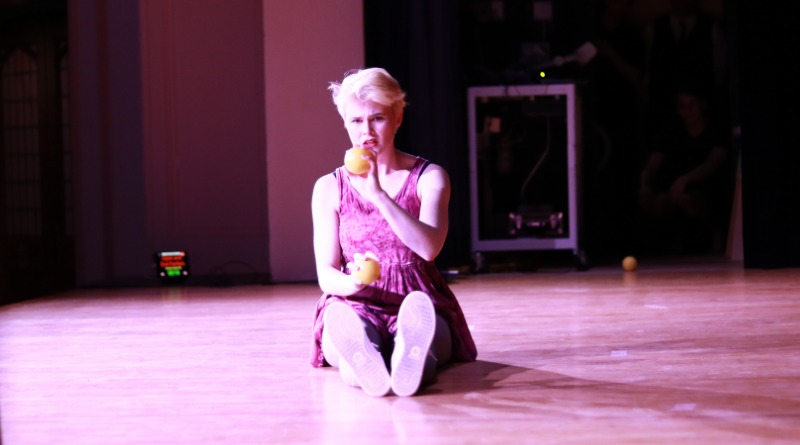A Hobbyist Perspective on the Relationship Between Jugglers and Props
This article is part of my ongoing doctoral research at York University’s Theatre and Performance Studies Program in Toronto, ON. The working title of my dissertation is We Have Always Been Jugglers: A Nonmodern Approach to Circus and it is supervised by Dr. Marlis Schweitzer. In this article, I think through some ideas emerging from interviews I conducted over Zoom in Summer 2021.

When I joined the juggling community a decade ago, I could not have guessed that I would be writing a PhD dissertation dedicated to my hobby today. My undergraduate thesis in Drama focused on the performance of objects in immersive, site-specific theatre, but in grad school my love for juggling spilled into my academics as I became more curious about the performance of objects in my own toss juggling practice. On the circus stage, the juggler’s body “is staged as physically (super) able” as it appears to be in command of an ever-increasing number of objects and, indeed, the force of gravity itself (Lievens and Paycha 21). The expert juggler, in complete control of the natural world as it bends to his will (1), is a perfect representation of what Pascal Jacob has called “the ultimate quest of humans: the desire to be free of worldly constraints” (34). However, although the juggler’s mastery of their craft might be read as a metaphor for human domination over nature by circus audiences, it is not my experience of practicing the craft as a juggler myself.
The circus researcher and dramaturg Bauke Lievens has pointed out the contradiction between how the circus body is represented to an audience versus what the artist themselves experiences while performing. The circus body is often staged as an “embodiment of… freedom,” but this image directly contradicts its reality as a highly disciplined, compliant, “incarnation of the norm” (“The Myth of Circus”). This narrative of freedom emerged with the modern circus in the Industrial Revolution, and Lievens argues that for contemporary circus to resonate more deeply with today’s audiences, circus artists/researchers need to write new myths that re-examine the human’s relationship to objects. Vincent Focquet suggests an alternative representation of the human-object relationship, which he calls the “humble circus.” A humble juggler is someone who “deliberately vacates their dominant position to seek out a more deferential relationship to the circus object” (45). A humble juggler decentres the human from their practice and listens to what the prop wants.
In conducting my own PhD research, I wondered what hobbyist jugglers could contribute to this conversation. I focus on hobbyist jugglers because I am a hobbyist myself, I owe a lot to the hobbyist juggling community, and I want to examine how jugglers relate to their props whenthere is no obligation or desire to make the juggler/prop relationship legible to an audience.(2) Do jugglers feel like they occupy a dominant position over their props like Focquet suggests? Or do they listen to what their props want? Do they take this into consideration at all? And what could performers and professionals learn from the hobbyist mindset towards props? Ultimately, I wonder what juggling interactions can teach us about interactions with the world in other respects and what politics a “juggling” approach to the world might imply.
Jugglers and Their Props

To complete this research, over the past year I have conducted semi-structured interviews with sixteen hobbyist jugglers in North America. I asked them, “What is the relationship between you and your props while juggling?” Some interviewees reflected quite deeply on the specifics of what happens between their body and the props while they are juggling. They considered the difference that prop type makes; for instance, how is juggling balls—which come into and then leave contact with the juggler’s body—a different experience than juggling flower sticks—which might never contact the juggler’s body, but rather are manipulated using sticks that act as extended limbs? Some jugglers focused on their emotional relationship with their props; for instance, how does a juggler choose the props that they buy, and why might they prefer to juggle their own balls, despite them having no obvious physical difference to others’ balls? Still other interviewees hypothesized about the differences between juggling by themselves and juggling with others; for instance, how do jugglers relate differently to a prop when it was originally thrown by their own hand versus when it was thrown by a passing partner?
One illuminating topic of conversation that came up during my interview process was the difference between how beginner and expert jugglers relate to their props. This difference was made clear to me during my interviews with Greg Phillips, who is the Dean of Engineering at the Royal Military College of Canada and taught me to juggle during my time at Queen’s University, and Tim Dresser, who is a software developer at Google and in my local juggling club.
For Phillips, the concept that took him the longest to recognize when he first learned to juggle was that, after the prop leaves his hand, it essentially has a mind of its own. “I shouldn’t be focusing on the path of the ball,” he told me, “I should be focusing on the path of my hand, because I can’t control the path of the ball, I can only control it while it’s in my hand.” This means that for a part of the pattern, him and the prop are “a single, physical moving unit,” but there’s another part of the pattern in which “the prop is gonna go off and do whatever it’s gonna do.” To improve his juggling, Phillips had to acknowledge that what the prop wants might be different than what he wants from the prop. This and other conversations I’ve had with jugglersduring my research suggest that experienced jugglers both fully accept the prop as a part of themselvesand fully accept that the prop is an individual with its own kind of agency.

Dresser identified a similar phenomenon in learning to juggle. There is a way to juggle, he told me, that ignores what the prop “wants.” When a beginner juggler learns to catch a ball, “they GRAB it, they have 100% control over that ball… And if the ball was a gosling, or like, a brick, nothing would change. They’re just exerting 100% full control over what they’re doing at the time.” Part of the point of props, though, Dresser believes, “is that they imply a kind of movement.” Like Phillips, Dresser also anthropomorphized his props to express their desire as separate from his own. Exerting total control over the props, he said, “doesn’t respect the way that the [props] want to move.” Focquet might consider Dresser a “humble juggler” because he tries to decentralize himself from the activity of juggling and instead “tunes” (Focquet’s word) to the prop. This idea of prop desire is worth further investigation. It suggests, for instance, that one method of moving away from a human-centric vision of the juggler/prop relationship is to look for the human in the prop. If a prop can express its desires, can it also express its hesitancies? Is there a situation in which it doesn’t get what it wants? How do we let our bodies be moved by the prop, rather than the other way around?
Disrupting Juggler/Prop Dualism
Lievens writes that the shift from human-controlling-object to object-controlling-human in contemporary circus is an important one because it better reflects our actual “contemporary experience of the world” (“The Need to Redefine”). However, some of my interviewees discussed juggling in a way that decentered the human from the act of juggling even further than a simple role reversal. Rather than asking how the prop is like the human, Matan Presberg, who is on the board of directors for the IJA (International Jugglers Association), questioned how his body is like a prop. In my interview with him, he reflected that, although juggling is enjoyable when he feels like he’s in control of the props, he’s never fully in control. The props are frequently doing something slightly different than he’s intending. “Which only makes them,” he explained, “a little bit different from the rest of my body. Because I have more control over my hands than over juggling props, but I still don’t have 100% absolute control over my hands.” Comments like this throughout my interview process reminded me that there is no use desiring freedom from the world because “’we’ are of the world” (emphasis in original, Barad 829). Beginner jugglers might try to control the nature of their props, but experts acknowledge that their body is a part of nature and their juggling is a result of the coming together of many “actants”(3) – including props and gravity.
Other statements made by my interviewees reflected this worldview by confusing and refuting traditional dualisms like those between human/nonhuman, culture/nature, activity/ passivity, and, most importantly for my research, juggler/prop. While theorizing alongside my interviewees, we asked questions that confused the juggler/prop distinction further and examined what “control” might mean in juggling relationships. For instance: At what point does an object(or a person) become a juggling prop? Can objects juggle and/or be jugglers? Are human bodies, or body parts, jugglable? Under what conditions?
What I wonder at this moment in my research is whether there are individual entities called “jugglers” and “props” that pre-exist the physical action of juggling at all. In the moment before a throw is made in a juggling pattern, given no context except that juggling will happen, how can it be known who/what will be thrown and who/what will do the throwing? Or, do these categories only emerge through the act of juggling itself? Philosopher and physicist Karen Barad’s concept of “intra-action,” when applied to juggling, would suggest that jugglers and props are not constraining categories that interact to create a juggling pattern, but rather, that a juggling pattern is an intra-action that determines the boundaries of juggler and prop. Everyone/thing has the potential to be both juggler and prop within them, but it is only through performance – execution of an action – that a categorization emerges. Conversations with jugglers during my interview process point towards this more performative understanding of what makes someone/thing a juggler or a prop.
Next Steps
This article has briefly examined a small section of what emerged from my conversational interviews with fellow hobbyist jugglers. Although none of the jugglers I interviewed consider themselves circus artists, this line of inquiry is relevant to circus performers as well. (4) If circus creators assume that categories like juggler (or acrobat, etc.) and prop (or apparatus) are fixed, then they risk excluding many possibilities for creation before they’ve even made it into the studio. (5) These conversations will also be relevant to scholars writing in the “Nonhuman Turn” (6) including within the fields of New Materialism and Speculative Realism. As I begin the writing process for my dissertation, I will be looking for connections between what hobbyist jugglers have told me and what those scholars are already thinking through.
If you would like to connect to discuss my research or any of the topics presented above, you can contact me here: [email protected].

.
Notes
(1) I use the gendered pronoun “his” in this instance because, historically, the expert juggler often is a man. And it is the individual male subject as universal that the nonhuman theories mentioned later in this text are trying to disrupt. See Grusin.
(2) My interviewees were all what I considered “serious hobbyist jugglers” within my own “juggling community.” For me, this meant they did not juggle for a living, they had been juggling for more than a year, and they interacted with the juggling community outside of their local juggling club (for instance, attending national or international juggling festivals, interacting with jugglers from other geographic areas online, etc.). However, as I continue my research, my understandings of juggling, jugglers, seriousness, hobbyism, and the “juggling community” are constantly shifting and will be contextualized further in my dissertation.
(3) This is Bruno Latour’s term for anything that is “the source of an action” (7).
(4)Circus actually didn’t come up as a topic of conversation in my interviews, except when I directly asked each interviewee, “What is your relationship to the circus, if any?” Most responded similarly to Eric Jackson, who has performed juggling at the IJA and other festivals across North America, when he said that his relationship to circus is, “not nonexistent, but not, not nonexistent.” A longer conversation about this separation between juggling and circus will occur in my dissertation.
(5) See Kann for a detailed discussion of how “overdetermination” threatens circus creation.
(6) This terminology comes from Grusin, who writes that, “the nonhuman turn… is engaged in decentering the human in favor of a turn toward and concern for the nonhuman” (vii).
.
Works Cited
Barad, Karen. “Posthumanist Performativity: Toward an Understanding of How Matter Comes to Matter.” Signs, vol. 28, no. 3, 2003, pp. 801-831.
Dresser, Tim. Personal Interview. 24 July 2021.
Focquet, Vincent, et al. “Footnotes on Mastery.” Thinking Through Circus, edited by Bauke Lievens, et al., Art Paper Editions, 2019.
Grusin, Richard, editor. The Nonhuman Turn, University of Minnesota Press, 2015.
Jackson, Eric. Personal Interview. 11 June 2021.
Jacob, Pascal. “The Quebecois Circus in the Concert of Nations: Exchange and Transversality.” Translated by Tiffany Templeton. Cirque Global: Quebec’s Expanding Circus Boudnaries, edited by Louis Patrick Leroux and Charles R. Batson, McGill-Queen’s University Press, 2016.
Kann, Sebastian. “Who Gets to Build the Future.” Open Letters to the Circus, https://www.circusdialogue.com/third-open-letter-circus. Accessed 25 May 2022.
Latour, Bruno. “On Actor-Network Theory.” Soziale Welt, vol. 47, 1996, pp. 369-381.
Lievens, Bauke. “The Myth Called Circus.” Open Letters to the Circus, https://www.circusdialogue.com/open-letters-circus-2. Accessed 25 May 2022.
Lievens, Bauke. “The Need to Redefine.” Open Letters to the Circus, https://www.circusdialogue.com/open-letters-circus-1. Accessed 25 May 2022.
Lievens, Bauke and Camille Paycha. “Making Space, Space, Space.” Thinking Through Circus, edited by Bauke Lievens, et al., Art Paper Editions, 2019.
Phillips, Greg. Personal Interview. 27 June 2021.
Presberg, Matan. Personal Interview. 27 July 2021.
...Do you have a story to share? Submit your news story, article or press release.





